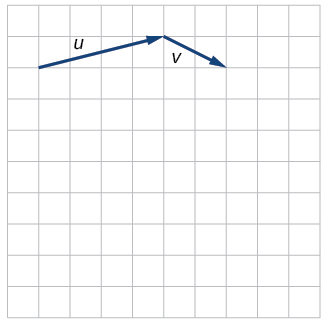10.8E : Vecteurs (exercices)
- Page ID
- 195552
Pour les exercices suivants, déterminez si les deux vecteurs,\(\mathbf{u}\) et\(\mathbf{v},\) sont égaux, où\(\mathbf{u}\) a un point initial\(P_{1}\) et un point terminal\(P_{2},\) et\(\mathbf{v}\) a un point initial\(P_{3}\) et un point terminal\(P_{4}\).
52. \(P_{1}=(-1,4), P_{2}=(3,1), P_{3}=(5,5)\)et\(P_{4}=(9,2)\)
53. \(P_{1}=(6,11), P_{2}=(-2,8), P_{3}=(0,-1)\)et\(P_{4}=(-8,2)\)
Pour les exercices suivants, utilisez les vecteurs\(\mathbf{u}=2 \mathbf{i}-\mathbf{j}, \mathbf{v}=4 \mathbf{i}-3 \mathbf{j},\) et\(w=-2 \mathbf{i}+5 \mathbf{j}\) évaluez l'expression.
54. \(u-v\)
55. \(2 v-u+w\)
Pour les exercices suivants, trouvez un vecteur unitaire dans la même direction que le vecteur donné.
56. \(a=8 i-6 j\)
57. \(b=-3 i-j\)
Pour les exercices suivants, déterminez l'amplitude et la direction du vecteur.
58. \(\langle 6,-2\rangle\)
59. \(\langle-3,-3\rangle\)
Pour les exercices suivants, calculez\(\mathbf{u} \cdot \mathbf{v}\).
60. \(u=-2 i+j\)et\(v=3 i+7 j\)
61. \(u=i+4 j\)et\(v=4 i+3 j\)
62. \(\boldsymbol{v}=\langle-3,4\rangle\)Tirage au sort\(\boldsymbol{v}, 2 \boldsymbol{v},\) et\(\frac{1}{2} \boldsymbol{v}\)
63. Compte tenu des vecteurs illustrés à la figure 4, esquissez\(\boldsymbol{u}+\boldsymbol{v}, \boldsymbol{u}-\boldsymbol{v}\) et\(3 \boldsymbol{v}\).

Graphique 4
64. Étant donné le point initial\(P_{1}=(3,2)\) et le point terminal,\(P_{2}=(-5,-1),\) écrivez le vecteur\(\mathbf{v}\) en termes de\(\mathbf{i}\) et\(\mathbf{j}\). Tracez les points et le vecteur sur le graphique.


